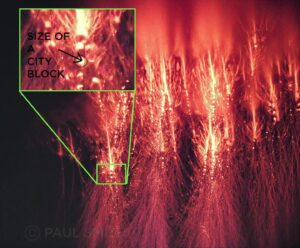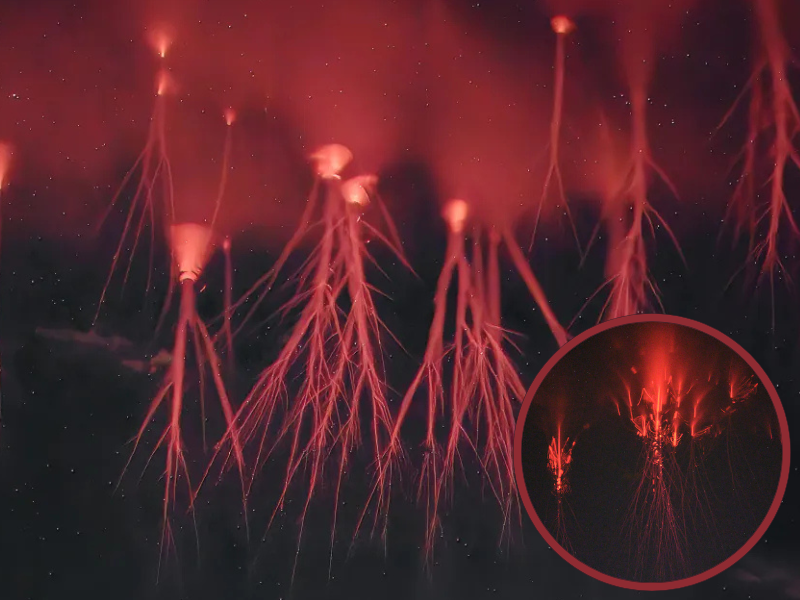Introduction
When most people imagine lightning, they picture bright bolts striking the ground. But high above some thunderstorms, an eerie and elusive phenomenon occurs—red sprites. These crimson flashes, lasting just milliseconds, are part of a group of electrical discharges called Transient Luminous Events (TLEs).
First captured on camera in 1989, red sprites remain one of the most mysterious and least understood weather events. In this article, we’ll explore:
✔ What red sprites are and how they form
✔ Where and when you can see them
✔ How they differ from other upper-atmospheric lightning
✔ Why scientists are so fascinated by them
What Are Red Sprites?
Red sprites are massive electrical discharges that occur 50–90 km (30–55 miles) above thunderstorms, far higher than normal lightning. Unlike typical downward lightning, sprites shoot upward in red-orange tendrils, resembling jellyfish or carrots.
Key Characteristics of Sprites
| Feature | Description |
|---|---|
| Color | Red at the top, fading to blue at the base |
| Shape | Jellyfish, carrot, or column-like |
| Duration | 3–10 milliseconds (extremely brief) |
| Size | 30–50 km wide—bigger than some hurricanes! |

Copyright Thanasis Papathanasiou
How Do Red Sprites Form?
Sprites are triggered by intense positive cloud-to-ground lightning. Here’s the science behind them:
- A powerful lightning strike removes a massive electrical charge from a thundercloud.
- The sudden discharge creates an electric field in the upper atmosphere.
- Nitrogen gas gets excited, emitting red light—forming the sprite.
Because they occur in the thin upper atmosphere, sprites are cold plasma discharges (unlike hot lightning) and produce no thunder.

Where Can You See Red Sprites?
Sprites are rare but most often appear over:
- Large, intense thunderstorms (mesoscale convective systems)
- Tropical or mid-latitude regions
Best Conditions for Viewing
✅ Clear, dark skies with distant storms (~200–500 km away)
✅ High vantage points (mountains, aircraft, or open plains)
✅ Low-light cameras (they’re too fast for the naked eye)
Red Sprites vs. Other TLEs
Sprites belong to a family of upper-atmospheric electrical phenomena:
| Phenomenon | Altitude | Color | Cause |
|---|---|---|---|
| Red Sprites | 50–90 km | Red | Positive lightning |
| Blue Jets | 20–50 km | Blue | Negative lightning |
| ELVES | 75–105 km | Red ring | Lightning EMP |
Why Are Scientists Studying Sprites?
Despite decades of research, sprites remain puzzling. Here’s why scientists are so interested:
🔹 Impact on the Ionosphere – Sprites may affect radio signals and satellite communications.
🔹 Energy Transfer – They help researchers understand how energy moves between atmospheric layers.
🔹 Gamma-Ray Connection – Some sprites are linked to terrestrial gamma-ray flashes (TGFs).
NASA and the ISS regularly capture sprites to learn more about their effects on Earth’s atmosphere.
How to Photograph Red Sprites
Want to capture these elusive flashes? Follow these tips:
📷 Use a DSLR or low-light camera (high ISO, wide aperture)
⏱ Long exposure (1–10 sec) to catch their brief glow
📍 Aim above distant storms (not directly overhead)
Conclusion
Red sprites are one of nature’s most stunning yet least understood phenomena. These brief, glowing bursts remind us that even in the age of advanced science, Earth’s atmosphere still holds mysteries.
Did You Know? The ISS has captured sprites from space! Next time you see a distant thunderstorm, look closely—you might witness this incredible light show.



